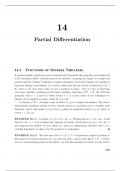Other
Partial derivative
- Course
- Institution
- Book
A book on partial derivatives of 14 would likely delve into advanced mathematical concepts, exploring how partial derivatives apply specifically to functions involving the number 14. It would cover topics such as finding rates of change in multivariable functions where 14 is a constant or variable ...
[Show more]



